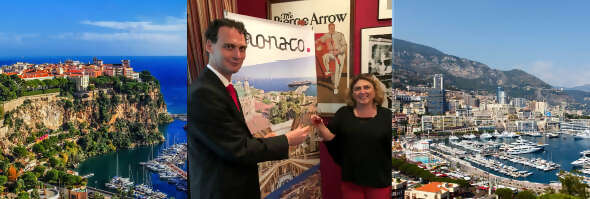Monaco. NOT JUST FOR THE RICH AND FAMOUS
Posted on 10/24/2016

Monaco. The name alone conjures images of gleaming mega-yachts in a spectacular harbour with a glistening Mediterranean backdrop to one side and an array of gorgeous Belle Epoque buildings hugging the mountainside on the other. Picture Grand Prix cars weaving through Monte Carlo’s winding roads, a celebrated casino with sophisticated Bondian types playing Chemin de Fer, and a liberal helping of the rich and famous swanning about in the Riviera sunshine - doesn’t it ever rain in Monaco?
Well yes, sometimes, but they average 300 days of sunshine. Monaco boasts an ideal Mediterranean climate throughout the year – mostly sunny - mild in the winter and warm and dry in the summer.
Recently the Principality sent its first-ever trade mission to Canada – calling in at Montreal, Toronto and Vancouver. We caught up with them in Toronto where Guy Antognelli, deputy general manager of the Monaco Government Tourist and Convention Authority hosted a media lunch which kicked off with a choice of champagne or a Princess Grace cocktail and a Monégasque hors d’oeuvre called Barbajuan, that yes, was definitely delicious, and I’d better try another couple just to be sure!
The tiny Principality, which covers approximately three quarters of square mile and is about half the size of New York’s Central Park, punches well above its weight when it comes to hosting events (over 200 annually), so luckily, is easily accessible – just a 25Km drive from the Nice Côte d’Azur International Airport.
“Ferraris are not mandatory (for the drive from Nice to Monaco) – you can take a helicopter,” jokes Antognelli, though it’s not really a joke, helicopter transfers are available.
Air Canada, Transat and various other carriers offer direct flights from Montreal to Nice.
Additionally, TGV high speed trains connect Monaco to Paris in six hours and from Milan in about four and a half hours.
Monaco boasts 2,500 rooms across 14 hotels, 80 percent of which are four and five star hotels - and even “a three star in Monaco is pretty well a four star in France,” says Antognelli.
The hotels range from legendary luxury establishments reflecting the glory and graciousness of earlier times to chic, modern resorts.
Monaco is also noted for its gastronomy, with 130 plus restaurants – six of which have a combined nine Michelin stars – letting the Principality boast the highest number of Michelin stars per square foot of any country.
There’s also lots of casual dining with many restaurants taking a fresh farm to table approach to cuisine. The Brasserie de Monaco, located in the harbour, is a 264-gallon boutique brewery producing an authentic local beer.
Visitors will want to check the local sights including the Prince’s Palace, which is open seasonally to the public. The Oceanographic Museum and Aquarium has one of the world’s largest collections of marine life. The Monaco Cathedral, which dates back to 1875, is the burial place of Prince Rainier and Princess Grace. Prince Rainier’s vintage car collection is housed in its own museum and the New National Museum of Monaco offers two venues with a focus on contemporary art.
Always popular, the Exotic Garden sits over a prehistoric cave and is also the site of the Anthropology Museum.
The events, as we mentioned earlier include, of course, the Grand Prix, the Monte Carlo Masters Tennis Tournament, The Monaco Yacht Show – a must for those checking out the mega-yacht category, The Circus Festival, of which Princess Stephanie is president, and one of the premier equestrian events of the year - the Longines Global Champions Tour for participants and aficionados of world-class show jumping.
Prince Albert II, like his father and grandfather before him, recognizes the importance the environment plays on his tiny country, and The Prince Albert II foundation which has chapters in Europe, the UK, the US and Canada, has allocated grants of more than US $23 million to over 185 projects around the world – specifically in the Mediterranean Basin, the Poles and the least developed countries.
Monaco was also one of the first nations to use reforestation to preserve its mountainous landscape, and as early as 1976, it instigated an agreement with France and Italy to protect the quality of its seawater and the sustainable development of its coastline.
And all this is apparently just scraping the surface of what Monaco has to offer.
Let us not forget that in Monaco in 1896, Chef Henri Charpentier decided to serve crêpes with Grand Marnier and orange juice to the visiting Prince of Wales – the future King Edward Vll. The story goes that the crêpes inadvertently caught fire as they were served and the delighted Prince who loved them asked they be named after his young companion, Suzette.
Voila Crepe Suzette!






